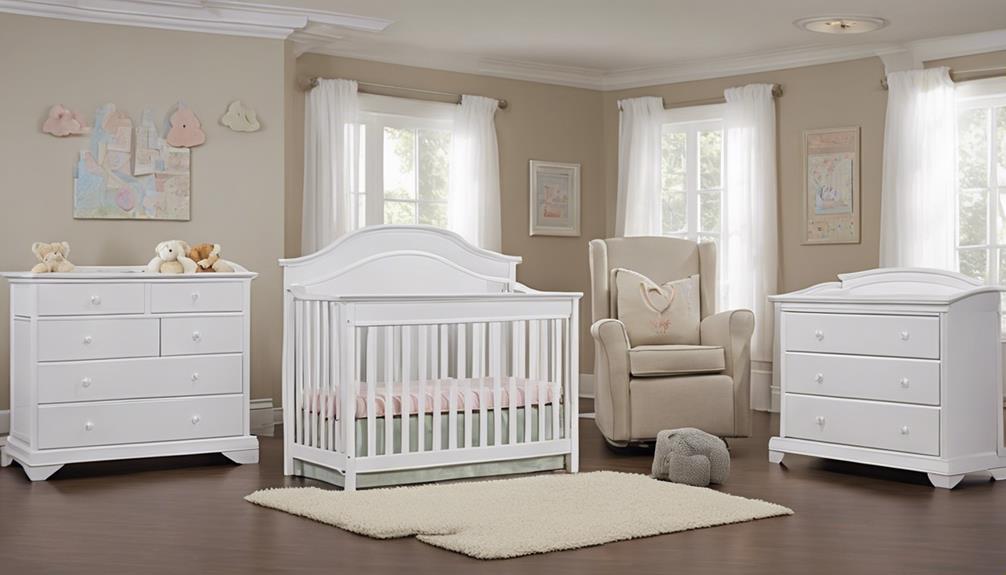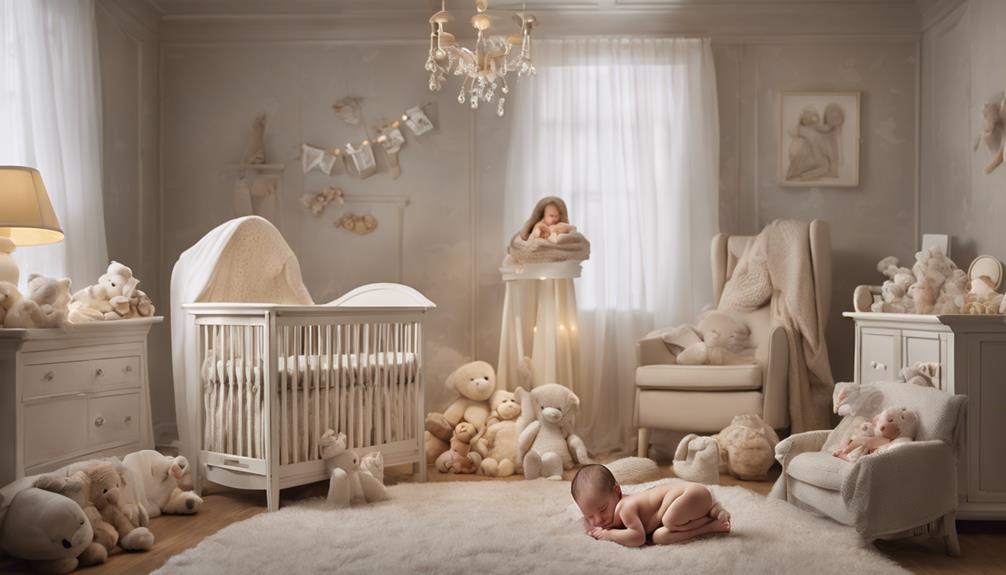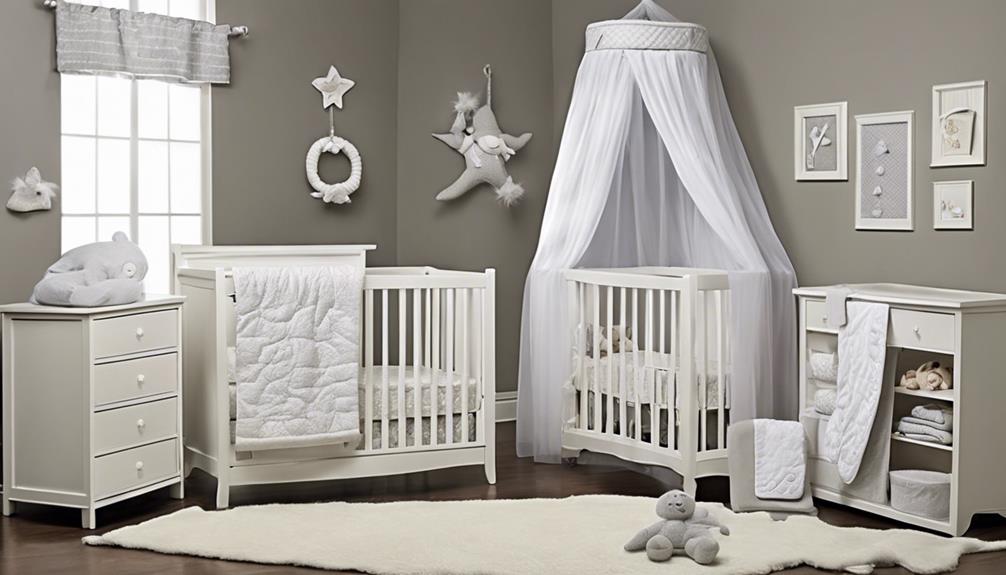So, you think getting your newborn to sleep in their crib feels like an impossible task? Don't worry; you're not alone in this struggle. We've all been there, staring at the crib like it's an unsolvable puzzle.
But fear not, because there are practical steps you can take to ease your little one into peaceful slumber in their crib. Let's unravel the mystery together and discover the secrets to a restful night for both baby and parent.
Key Takeaways
- Establish a consistent bedtime routine and soothing environment in the crib.
- Ensure crib safety by avoiding loose bedding and maintaining a comfortable room temperature.
- Introduce the crib gradually during playtime and offer comfort during the transition.
- Utilize white noise, calming activities, and dim lights to signal bedtime for better sleep.
Establishing a Relaxing Bedtime Routine
Creating a calming bedtime routine for your baby is essential in helping them relax and sleep soundly in their crib. Start by giving your newborn a warm bath and a gentle massage to unwind. Engage in soothing activities like singing or reading a bedtime story to create a peaceful atmosphere before placing them in the crib.
Utilize white noise or a lullaby to help your little one drift off to sleep. Dimming the lights in the room can signal bedtime and establish a sleep-friendly environment for your baby. Remember, consistency is key. Maintaining the same bedtime routine each night will help your baby associate it with sleep in the crib, promoting a sense of security and comfort.
Addressing Baby's Crib Discomfort

To guarantee your newborn's comfort in the crib, it's essential to meticulously assess the firmness and snug fit of the mattress. A properly fitted crib mattress reduces the risk of discomfort during sleep.
Avoid using loose bedding, pillows, or stuffed animals in the crib, as these items may hinder your baby's ability to sleep peacefully. Checking the room temperature is also vital to make sure a comfortable sleep environment for your little one.
Consider using a sleep sack or swaddle to provide a sense of security and comfort in the crib, mimicking the coziness of the womb.
By addressing any signs of discomfort such as fussiness, restlessness, or crying promptly, you can create a safe sleeping space that promotes healthy sleep habits for your newborn.
Transitioning to Crib Sleep

Shifting your newborn to crib sleep can be a gradual process that requires patience and consistency. It's common for babies to resist sleeping in a crib initially due to the unfamiliar environment, but with the right approach, you can help them adjust smoothly.
Here are some tips to aid in this change:
- Introduce the crib gradually: During playtime, let your newborn explore and become comfortable with the crib.
- Establish a consistent bedtime routine: Create a calming routine that signals it's time for sleep in the crib.
- Offer comfort and reassurance: Stay close to provide comfort and reassurance as your baby gets used to sleeping in the crib.
- Monitor comfort levels: Pay attention to your newborn's cues and adjust the sleep environment as needed for the best comfort.
- Create a soothing environment: Make sure the crib is a cozy and safe space for your little one to encourage better sleeping habits.
Implementing Consistent Sleep Strategies

Establishing consistent sleep strategies is key to helping your newborn associate the crib with restful and soothing sleep cues. To make sure your baby falls asleep peacefully, create a bedtime routine that includes calming activities like a warm bath and gentle massage.
Incorporate white noise in the crib to help your baby relax and drift off to sleep. Maintaining a consistent bedtime to establish a routine that signals rest time for your little one is vital. Additionally, consider using a night-light or mobile to provide visual stimulation that can comfort your baby and signal when it's time to sleep.
Building familiarity with the crib is important; try leaving your baby in the crib for short periods during awake time to help them feel safe and comfortable in their sleep space. By following these strategies, you can help your baby feel secure and content in their crib, making it a safe place for them to sleep peacefully.
Ensuring Crib Safety and Comfort

Creating a safe and comforting sleep environment in the crib is paramount for your newborn's well-being and peaceful rest. Here are some key tips to make sure your baby's crib is a safe haven for sleep:
- Make sure there are no gaps between the crib mattress and rails to prevent entrapment hazards.
- Use only a tight-fitting sheet in the crib to avoid suffocation risks from loose bedding.
- Keep the crib bare with no pillows, blankets, or toys to reduce the risk of Sudden Infant Death Syndrome (SIDS).
Place the crib in a quiet and dark room to create a conducive sleep environment for the baby. Implement calming movements and a soothing voice to help your baby feel secure and comfortable in the crib.
Conclusion
In the journey of helping our newborn sleep in their crib, we must remember that patience and persistence are key.
Like a gentle lullaby, our consistent efforts to create a safe and soothing sleep environment will eventually lead to peaceful nights for both baby and parents.
By following the steps outlined in this guide with love and understanding, we can help our little ones develop healthy sleep habits and thrive.
Sweet dreams await!










